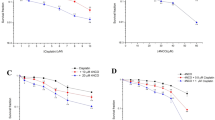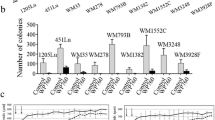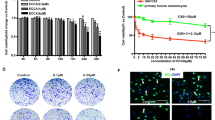Abstract
Melanoma is one of the most chemoresistant cancers in patient care. The remission rate of current therapy remains low. DC-81, an antitumor antibiotic produced by Streptomyces species, belongs to pyrrolo[2,1-c][1,4]benzodiazepine (PBD), which is a potent inhibitor of nucleic acid synthesis. An enediyne contains either DNA intercalating groups or DNA minor groove binding functions and these are potent DNA-damaging agents due to their ability to generate benzenoid diradicals. We have previously reported an efficient synthesis and antitumor activity of a series of novel PBD hybrids linked with enediyne. The purpose of this study was to examine the mechanism of the antiproliferative effect of DC-81-enediyne agent on human melanoma A375 cells. DC-81-enediyne induced an increase in Ca2+ level and reactive oxygen species (ROS) generation as detected by flow cytometric assay. Western blot analysis showed that DC-81-enediyne induced the phosphorylation of p38 and activating transcription factor 2 (ATF-2). By using the luciferase reporter assay, activating protein-1 (AP-1) activity was further enhanced after A375 cells were treated with graded concentrations of DC-81-enediyne. DC-81-enediyne treatment-induced A375 cell apoptosis was significantly abrogated by the addition of Ca2+, ROS, and p38 inhibitors. Collectively, our studies indicate that DC-81-enediyne induces A375 cell apoptosis through an increased Ca2+ and ROS generation, which involves p38 phosphorylation and enhanced ATF-2/AP-1 expressions, leading to caspase-3 activity, poly(ADP-ribose)polymerase cleavage, M30 CytoDeath staining, and subsequent apoptotic cell death.









Similar content being viewed by others
Abbreviations
- AP-1:
-
Activating protein-1
- ATF-2:
-
Activating transcription factor 2
- DCFH-DA:
-
2′,7′-Dichlorofluorescein diacetate
- DMEM:
-
Dulbecco’s minimal essential medium
- ERK:
-
Extracellular signal-regulated kinase
- JNK:
-
c-Jun N-terminal kinase
- MAPK:
-
Mitogen-activated protein kinase
- PARP:
-
Poly(ADP-ribose)polymerase
- PBD:
-
Pyrrolo[2,1-c][1,4]benzodiazepine
- ROS:
-
Reactive oxygen species
References
Aggeli IK, Gaitanaki C, Beis I. Involvement of JNKs and p38-MAPK/MSK1 pathways in H2O2-induced upregulation of heme oxygenase-1 mRNA in H9c2 cells. Cell Signal. 2006;18:1801–12.
Ameyar M, Wisniewska M, Weitzman JB. A role for AP-1 in apoptosis: the case for and against. Biochimie. 2003;85:747–52.
Bacus SS, Gudkov AV, Lowe M, Lyass L, Yung Y, Komarov AP, Keyomarsi K, Yarden Y, Seger R. Taxol-induced apoptosis depends on MAP kinase pathways (ERK and p38) and is independent of p53. Oncogene. 2001;202:147–55.
Barzilai A, Yamamoto K. DNA damage responses to oxidative stress. DNA Repair. 2004;3:1109–15.
Brantley-Finley C, Lyle CS, Du L. The JNK, ERK and p53 pathways play distinct roles in apoptosis mediated by the antitumor agents vinblastine, doxorubicin, and etoposide. Biochem Pharmacol. 2003;66:459–69.
Buttke TM, Sandstrom PA. Oxidative stress as a mediator of apoptosis. Immunol Today. 1994;15:7–10.
Choi EM. Regulation of intracellular Ca(2+) by reactive oxygen species in osteoblasts treated with antimycin A. J Appl Toxicol. 2012;32:118–25.
Cross PE, Dickinson RP, Parry MJ, Randall MJ. Selective thromboxane synthetase inhibitors. 3. 1H-imidazol-1-yl-substituted benzo[b]furan-, benzo[b]thiophene-, and indole-2- and -3-carboxylic acids. J Med Chem. 1986;29:1637–43.
Engesæter B, Engebraaten O, Flørenes VA, Mælandsmo GM. Dacarbazine and the agonistic TRAIL receptor-2 antibody lexatumumab induce synergistic anticancer effects in melanoma. PLoS One. 2012;7:e45492. doi:10.1371/journal.pone.0045492.
Garbe C, Eigentler TK. Diagnosis and treatment of cutaneous melanoma: state of the art 2006. Melanoma Res. 2007;17:117–27.
Gius D, Botero A, Shah S, Curry HA. Intracellular oxidation/reduction status in the regulation of transcription factors NF-kappaB and AP-1. Toxicol Lett. 1999;106:93–106.
Gupta A, Rosenberger SF, Bowden GT. Increased ROS levels contribute to elevated transcription factor and MAP kinase activities in malignantly progressed mouse keratinocyte cell lines. Carcinogenesis. 1999;20:2063–73.
Hess J, Angel P, Schorpp-Kistner M. AP-1 subunits: quarrel and harmony among siblings. J Cell Sci. 2004;117:5965–73.
Hsieh MC, Hu WP, Yu HS, Wu WC, Chang LS, Kao YH, Wang JJ. A DC-81-indole conjugate agent suppresses melanoma A375 cell migration partially via interrupting VEGF production and stromal cell-derived factor-1α-mediated signaling. Toxicol Appl Pharmacol. 2011;255:150–9.
Hu WP, Wang JJ, Lin FL, Lin YC, Lin SR, Hsu MH. An efficient synthesis of pyrrolo[2,1-c]-[1,4]benzodiazepine. Synthesis of the antibiotic DC-81. J Org Chem. 2001;66:2881–3.
Hu WP, Yu HS, Sung PJ, Tsai FY, Shen YK, Chang LS, Wang JJ. DC-81-indole conjugate agent induces mitochondria mediated apoptosis in human melanoma A375 cells. Chem Res Toxicol. 2007;20:905–12.
Hu WP, Tsai FY, Yu HS, Sung PJ, Chang LS, Wang JJ. Induction of apoptosis by DC-81-indole conjugate agent through NF-kappaB and JNK/AP-1 pathway. Chem Res Toxicol. 2008;21:1330–6.
Hu WP, Liang JJ, Kao CL, Chen YC, Chen CY, Tsai FY, Wu MJ, Chang LS, Chen YL, Wang JJ. Synthesis and antitumor activity of novel enediyne-linked pyrrolo[2,1-c][1,4]benzodiazepine hybrids. Bioorgan Med Chem. 2009;17:1172–80.
Jemal A, Devesa SS, Hartge P, Tucker MA. Recent trends in cutaneous melanoma incidence among whites in the United States. J Natl Cancer Inst. 2001;93:678–83.
Karin M, Liu ZG, Zandi E. AP-1 function and regulation. Curr Opin Cell Biol. 1997;9:240–6.
Konishi M, Ohkuma H, Tsuno T, Oki T, VanDuyne GD, Clardy J. Crystal and molecular structure of dynemicin A: a novel 1,5-diyn-3-ene antitumor antibiotic. J Am Chem Soc. 1990;112:3715–6.
Krol J, Mengele K, Ottl-Mantchenko I, Welk A, Wasilewitsch I, von Steinburg SP, Schneider KT, Schmitt M. Ex vivo detection of apoptotic trophoblast cells applying flow cytofluorometry and immunocytochemistry using M30 antibody directed to the cytokeratin 18 neo-epitope. Int J Mol Med. 2005;16:415–20.
Lee CH, Hu WP, Hong CH, Yu HS, Liao WT, Chen CY, Chen YL, Chen BH, Chen GS, Wang JJ. Pyrrolo[2,1-c][1,4]benzodiazepine and indole conjugate (IN6CPBD) has better efficacy and superior safety than the mother compound DC-81 in suppressing the growth of established melanoma in vivo. Chem Biol Interact. 2009;180:360–7.
Lee MD, Dunne TS, Siegel MM, Chang CC, Morton GO, Borders DB. Calichemicins, a novel family of antitumor antibiotics. 1. Chemistry and partial structure of calichemicin.gamma.1I. J Am Chem Soc. 1987;109:3464–6.
Lipton SA, Nicotera P. Calcium, free radicals and excitotoxins in neuronal apoptosis. Cell Calcium. 1998;23:165–71.
Mahboobi S, Pongratz H, Hufsky H, Hockemeyer J, Frieser M, Lyssenko A, Paper DH, Bürgermeister J, Böhmer FD, Fiebig HH, Burger AM, Baasner S, Beckers T. Synthetic 2-aroylindole derivatives as a new class of potent tubulin-inhibitory, antimitotic agents. J Med Chem. 2001;44:4535–53.
Merighi S, Simioni C, Gessi S, Varani K, Mirandola P, Tabrizi MA, Baraldi PG, Borea PA. A2B and A3 adenosine receptors modulate vascular endothelial growth factor and interleukin-8 expression in human melanoma cells treated with etoposide and doxorubicin. Neoplasia. 2009;11:1064–73.
Mingo-Sion AM, Marietta PM, Koller E, Wolf DM, Van Den Berg CL. Inhibition of JNK reduces G2/M transit independent of p53, leading to endoreduplication, decreased proliferation, and apoptosis in breast cancer cells. Oncogene. 2004;23:596–604.
Morton S, Davis RJ, Cohen P. Signalling pathways involved in multisite phosphorylation of the transcription factor ATF-2. FEBS Lett. 2004;572:177–83.
Nagata Y, Todokoro K. Requirement of activation of JNK and p38 for environmental stress-induced erythroid differentiation and apoptosis and of inhibition of ERK for apoptosis. Blood. 1999;94:853–63.
Nicolaou KC, Dai WM. Chemistry and biology of the enediyne anticancer antibiotics. Angew Chem Int Ed Engl. 1991;30:1387–416.
Nicotera P, Orrenius S. The role of calcium in apoptosis. Cell Calcium. 1998;23:173–80.
Orrenius S, Zhivotovsky B, Nicotera P. Regulation of cell death: the calcium–apoptosis link. Nat Rev Mol Cell Biol. 2003;4:552–65.
Qian Y, Guan T, Huang M, Cao L, Li Y, Cheng H, Jin H, Yu D. Neuroprotection by the soy isoflavone, genistein, via inhibition of mitochondria-dependent apoptosis pathways and reactive oxygen induced-NF-κB activation in a cerebral ischemia mouse model. Neurochem Int. 2012;60:759–67.
Roulston A, Reinhard C, Amiri P, Williams LT. Early activation of c-Jun N-terminal kinase and p38 kinase regulate cell survival in response to tumor necrosis factor alpha. J Biol Chem. 1998;273:10232–9.
Salvesen GS, Dixit VM. Caspases: intracellular signaling by proteolysis. Cell. 1997;91:443–6.
Sambrook J, Russell DW. Assay for β-galactosidase in extracts of mammalian cells. In: Irwin N, editor. Molecular cloning, vol. 17. Cold Spring Harbor: Cold Spring Harbor Laboratory Press; 2001a. p. 48–51.
Sambrook J, Russell DW. Assay for luciferase in extracts of mammalian cells. In: Irwin N, editor. Molecular cloning, vol. 17. Cold Spring Harbor: Cold Spring Harbor Laboratory Press; 2001b. p. 42–7.
Scott B, Eaton CJ. Role of reactive oxygen species in fungal cellular differentiations. Curr Opin Microbiol. 2008;11:488–93.
Shaulian E, Karin M. AP-1 as a regulator of cell life and death. Nat Cell Biol. 2002;4:131–6.
Shi Y. Mechanisms of caspase activation and inhibition during apoptosis. Mol Cell. 2002;9:459–70.
Simon HU, Haj-Yehia A, Levi-Schaffer F. Role of reactive oxygen species (ROS) in apoptosis induction. Apoptosis. 2000;5:415–8.
Stoian I, Oros A, Moldoveanu E. Apoptosis and free radicals. Biochem Mol Med. 1996;59:93–7.
Susin SA, Zamzami N, Kroemer G. Mitochondria as regulators of apoptosis: doubt no more. Biochim Biophys Acta. 1998;1366:151–65.
Tobiume K, Matsuzawa A, Takahashi T, Nishitoh H, Morita K, Takeda K, Minowa O, Miyazono K, Noda T, Ichijo H. ASK1 is required for sustained activations of JNK/p38 MAP kinases and apoptosis. EMBO Rep. 2001;2:222–8.
Wang JJ, Shen YK, Hu WP, Hsieh MC, Lin FL, Hsu MK, Hsu MH. Design, synthesis, and biological evaluation of pyrrolo[2,1-c][1,4]benzodiazepine and indole conjugates as anticancer agents. J Med Chem. 2006;49:1442–9.
Wu J, Suzuki H, Akhand AA, Zhou YW, Hossain K, Nakashima I. Modes of activation of mitogen-activated protein kinases and their roles in cepharanthine-induced apoptosis in human leukemia cells. Cell Signal. 2002;14:509–15.
Xiao D, Singh SV. Phenethyl isothiocyanate-induced apoptosis in p53-deficient PC-3 human prostate cancer cell line is mediated by extracellular signal-regulated kinases. Cancer Res. 2002;62:3615–9.
Xu C, Shen G, Yuan X. ERK and JNK signaling pathways are involved in the regulation of activator protein 1 and protein 1 and cell death elicited by three isothiocyanates in human prostate cancer PC-3 cells. Carcinogenesis. 2006;27:437–45.
Zhu F, Zhang Y, Bode AM, Dong Z. Involvement of ERKs and mitogen- and stress-activated protein kinase in UVC-induced phosphorylation of ATF2 in JB6 cells. Carcinogenesis. 2004;25:1847–52.
Acknowledgments
We thank the National Science Council of the Republic of China and the Kaohsiung Medical University Research Foundation for the financial support.
Author information
Authors and Affiliations
Corresponding author
Electronic supplementary material
Below is the link to the electronic supplementary material.
ESM 1
(DOC 4980 kb)
Rights and permissions
About this article
Cite this article
Chen, CY., Chen, YK., Wang, JJ. et al. DC-81-enediyne induces apoptosis of human melanoma A375 cells: involvement of the ROS, p38 MAPK, and AP-1 signaling pathways. Cell Biol Toxicol 29, 85–99 (2013). https://doi.org/10.1007/s10565-012-9238-6
Received:
Accepted:
Published:
Issue Date:
DOI: https://doi.org/10.1007/s10565-012-9238-6




